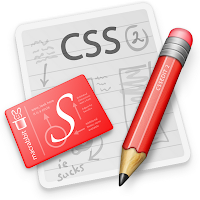Hi friends!!! For the past few weeks, I keep receiving a lot of emails regarding the footer which I added on my blog. So, It's been a fascination around the blogosphere to have a footer similar to the one installed on my blog. The same could be found on shoutmeloud, techiemania, etc.. The customization is basically a paid one, when it comes to thesis theme where as, we blogspot users can enjoy it for free!!!
I do not want to take much of your time. It's already going to little tiring for you to install this footer on your blog. How ever, I would like to inform you that I'm working on the thesis theme exactly similar to Shoutmeloud. I will be launching it in a few weeks time once I fully complete the design work. I suggest you to subscribe to my blog so that you don't miss the first copy of such a customized thesis theme. Let's move to the footer customization now.
1. Go to "Design->Edit HTML. Make a backup of your template before modifying the HTML by clicking on the "Download full template" link at the top of the page.
2. Once the backup is made, search for the following line in your template. Use "CTRL+F" to fasten your search results.
3. Let's add the CSS part of the footer first. So, just add the code mentioned in this document - CSS For Thesis Theme Footer above the line mentioned in step 2. That is, you need to copy the entire code in the document and paste it just above the line mentioned in step 2. Save your template temporarily. 4. Next, search for the last closing div tag on your template page. That is, just scroll to the end of the page and see the last closing div tag.
5. Paste the code mentioned in this text document - Code For Thesis Theme Footer just above the last div tag. Else, you can place it just above </body> tag. 6. Just preview your template. If you find any errors, then contact me via email and I will help you with the installation. However, if you do not encounter any error, then have a look at the footer and close the tab. I recommend you to save the template again.
7. The major customization work starts here. I have already mentioned very clearly in the text document what to be changed. So, if you are webmaster, I'm sure it should be self explanatory for you guys!!! If you are not an expert, well, here goes the customization procedure.
FOOTER CUSTOMIZATION
1. Just replace the following text - LABEL 1 with your blog labels. Next, find the following code in the footer - YOUR URL THAT LINKS TO THE LABELS. Replace this piece of text with the URL of your labels. To obtain the URL of the various labels in your blog, just hover your mouse over a published post which has got some labels. Check out the following picture for better understanding.
Alternate method : To get the URL of your labels, just paste your blog url followed by a '/search/label/' and write down the blog label as such. Note that, if you have a space in the name of your labels, then each space should be replaced by %20. For example, let us assume that your blog label is BLOGGER TUTORIAL - has got a space between the word BLOGGER and TUTORIAL. So, the URL of your label should be as follows.
http://www.yourblogname.com/search/label/BLOGGER%20TUTORIAL.
This procedure should be followed for all the instances, (I have provided 12 such instances in the text document) where you find the text "YOUR URL THAT LINKS TO THE LABELS".
2. Just replace the following text - Featured Article 1 with the title of your featured content. Next, find the following code in the footer - URL THAT LINKS TO A FEATURED CONTENT ON YOUR BLOG. Replace this piece of text with the URL of your featured content. I think it is pretty self explanatory. Repeat the same for all the instances where you find the above text. I have provided 6 such instances in the text document.
3. Just replace the following text - WEBSITE 1 with the title of site you wish to link to. Next, find the following code in the footer - BLOG ROLL LINK. Replace this piece of text with the URL of site which you wish to link to. The number of sites you may link on your blog according to the coding I provided is 3. How ever, you can extend the same to any number by just following the pattern of coding. That is, add the following piece of tags if you wish to add another site to your blog roll.
4. Just replace the following text - POPULAR POST TITLE 1 with the title of your featured content. Next, find the following code in the footer - URL OF POPULAR POST ON YOUR BLOG. Replace this piece of text with the URL of your popular post. If you are not sure about the post which receives the maximum hits, then I suggest you to visit Google Analytics. So, just repeat the same for all the instances where you find the above texts. I have provided 7 such instances in the text document.
5. This step deals with the author. So, I suggest you to have a photo of yourself (Size:) and some text about yourself. That's it. Upload your photo to PICASA and get the URL to the image. Replace the text "URL OF YOUR PROFILE PHOTO" with the URL you got from PICASA. Next, split the content which you have about yourself in three parts and replace the text which says "About Yourself" at three instances with the three parts you have about yourself. That's it! Should be simple, I believe!!!
Find the following text - YOUR USERNAME, replace this text with your twitter user name. Next, replace the text "YOUR FACE BOOK FAN PAGE URL" with the URL of your facebook fan page URL.
6. We have reached the last part of the customization. Just replace the text which says "ALEXA WIDGET FOR YOUR SITE" with the widget you receive from Alexa website. I feel it is pretty self explanatory. Last but not the least, replace all the instances of the text - "YOUR BLOG TITLE" and "YOUR BLOG URL" with title of your blog and URL of your blog respectively. That's it! Save your template!!!
I tried to keep the installation procedure as simple as possible. How ever, if you feel the post needs a little more elaboration, then share your views via comments. So, I will update the post and make things more clear. I hope you enjoy the thesis theme footer on your blogspot/blogger blog.
If you've got any doubts or issues installing this footer on your blog, then contact me via email or just leave a comment below. I will reply to you as soon as possible. I forget to mention that the footer involves a logo. So, if you wish to have a customized logo for your blog and get it displayed at footer, then you may use our services to get one. See you soon in another interesting tutorial. 







